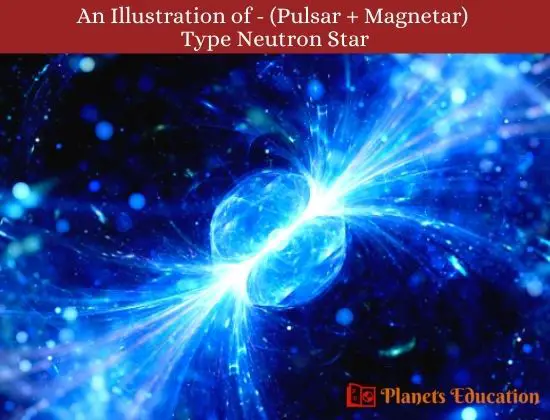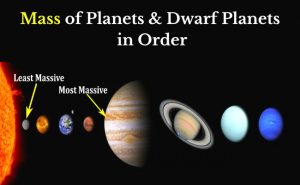A neutron star is a collapsed core of a red supergiant star. When a supernova explosion happens in the core of a massive star that has a range of 8 to 40 solar masses, then a Neutron Star originates.
The classification of stars is done by considering their size, physical appearance, and mass. A Neutron star is one of the smallest and densest types of stars. (Check below the Types of Stars). The approximate size of these stars is just 20 kilometers in diameter. With this small size, the mass reaches approximately 1.4 solar masses due to its high density.
Must Check:- Life Cycle of all the different Types of Stars
Here in this post, you will know about neutron star facts, their types, density, size, and some other astonishing information about it.
Best facts about Neutron Stars
Here you will know some interesting Neutron Star Facts:
Smallest known star-type
There are many phases of massive type stars (if you have checked the above link). And Neutron stars are the result of collapsed core of the red supergiant star. So they are smaller in size.
But the fact is, Neutron stars are the smallest types of known stars. Well, some other star types like Quark Stars and Strange Stars are smaller than it, but they are hypothetical objects.
Extreme dense star
The neutron star is one of the extremely known dense stars. In the life cycle of a main-sequence star, only a stellar black hole is denser than it. Just to compare, the density of neutron stars is more than 100 billion times the density of the sun.
They rotate very fast
Due to the conservation of angular momentum, the core of collapsed star starts rotating faster. It results in newly formed neutron stars rotates up to several hundred times per second. These stars emit a beam of electromagnetic radiation from a region of their magnetic pole and this makes them detectable as pulsars.
The fastest known rotating neutron star’s name is PSR J1748-2446ad, which has a rotating speed of around 716 times per second. If we calculate its linear speed for any atom on its surface, it would be around 24% of the speed of light.
They are very hot
The temperature of neutron stars is very high and the surface temperature can be up to 600,000 K. Just to compare with the sun, the surface temperature of our sun is around 5500 K.
And for the interesting fact about Neutron Stars, a newly formed neutron star has an inside temperature of around 100-1000 billion Kelvin. But after a few years, the temperature drops and reaches its normal level of 600,000 Kelvin. And this is also a very hot range compared to other stellar objects’ temperatures.
Milky Way Galaxy has millions of Neutron Stars
There are billions of stars in our milky way galaxy (check it – List of Stars in Milky Way). Each and every type of star has been found in our galaxy. Currently, there are 2000 neutron stars that have been found in our galaxy milky way. And mostly are pulsars (pulsars are one of the types of neutron stars).
- Read about:- Milky Way Stars – Names, Numbers, and List
According to an estimation by scientists, there are around one billion neutron stars just in our galaxy. These stars are difficult to detect and only 2000 have been detected so far.
These stars can host planets
Neutron stars can have exoplanets (planets outside of the solar system called exoplanets). The two pulsars have been found yet that have at least one planet in their system. These planets are also known as Pulsar Planet.
The first detected neutron star system that has three planets Draugr, Poltergeist, and Phobetor, was discovered in 1992-1994. There are other lists of exoplanets for neutron stars but they are unconfirmed candidates yet.
Must check:- Exoplanet Facts and Information
Gravity is billions of times higher than Earth
Neutron stars are celestial objects that have too much gravity. The gravitational force of these stars is around 200 billion times stronger than earth’s gravity.
Its gravity is near around 2 × 1012 m/sec2. Due to this strong gravitational field, light emitted from it get bends and this effect is called gravitational lensing.
Read About:- What is Gravity and Gravitational Force?
If a normal object were to fall from a height of just 1 meter on the surface of a neutron star that has a size of around 20 km, then before touching the surface its speed would reach around 1400 km/sec. This is just because of its high gravity.
Types of Neutron Star
Mainly there are two types of Neutron Stars, Pulsars and Magnetars.
Pulsars
Most neutron stars are found in form of Pulsars. Pulsars are highly rotating neutron stars that emit beams of electromagnetic radiation from their magnetic poles. A pulsar is only detectable when its beam points toward the earth.
Pulsars are observed to have pulses of traditions that observe at regular intervals of milliseconds to seconds. The first pulsar star was observed on 28 Nov 1967 and observed pulses were separated by a time interval of 1.33 seconds. Usually, they rotate/spin very fast but slow rotating pulsars are very difficult to detect.

Magnetars
Another type of Neutron Star is Magnetars and usually, they have a very strong magnetic field. All neutron stars have high magnetic fields but Magnetar’s magnetic field is around 1000 times stronger. They have magnetic fields in order of (∼109 to 1011 T, ∼1013 to 1015 G) which is around 1 billion to 1 quadrillion times stronger than the earth’s magnetic field.
Usually, a magnetar is a slow rotator. A typical neutron star rotates 1-10 times per second but a magnetar rotates 0.2-1 times every second. The magnetic field of a magnetar is around 100 million times stronger than any artificial magnet made by men so far.
Also, the third type of neutron star is Pulsar + Magnetar type. They have properties of both types.
Must Read:- Magnetosphere of the Earth?
Neutron Star Density
The density of the neutron stars is quite high and it is the densest known star. Its density is more than a trillion times the Sun. A typical neutron star has a density in the range of 4.0×1017 kg/m3 to 6.0×1017 kg/m3. Whereas the average density of this star is 5.0×1017 kg/m3 which is around 300,000 billion times the density of the sun.
Its density is more when compared with the nucleus of an atom (the approximate density of an atomic nucleus is 3×1017 kg/m3). Because of their extremely high density, they are too heavy weight.
Neutron Star Size
Usually, neutron stars are very small in size and they are the smallest type of known star. Their size can range from 18 to 23 kilometers in diameter. With this small size, the mass of these stars can range from 1 to 3 solar masses, because of their high density. Whereas, the usual/average size is around 20 km with an approximate mass of 1.4 times the sun.
An astonishing fact regarding neutron star size:-
| A neutron star with just 5 cm diameter is more massive compared to our earth. |
Let’s check it mathematically,
20 km size neutron star – 1.4 × mass of the sun
⇒ 20 km → 1.4 × 2 × 1030
⇒ 20 × 1000 × 100 cm → 1.4 × 2 × 1030
⇒ 1 cm → 1.4 × 1024
⇒ 5 cm → 7.0 × 1024
So, mathematically a 5 cm size neutron star would weigh around 7.0 × 1024 kg. Whereas the mass of the earth is around 6.0 × 1024 kg.
This was some interesting information about neutron stars, with some awesome facts and other relevant information like size, density, and comparison. Hope you have liked this post, check below for more interesting posts about planets and astronomy.
Related Posts:-



